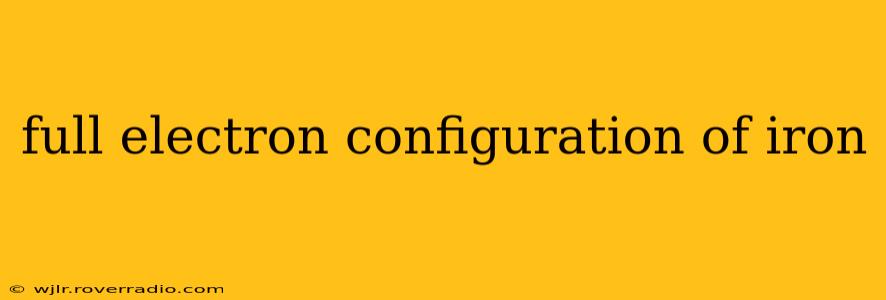Iron, a ubiquitous element crucial to life and industry, boasts a fascinating electron configuration. Understanding this configuration unlocks insights into its chemical properties and its diverse roles in biological and technological systems. This article will explore the full electron configuration of iron, answering common questions and delving into its implications.
What is the full electron configuration of iron?
The full electron configuration of iron (Fe), atomic number 26, is 1s²2s²2p⁶3s²3p⁶4s²3d⁶. This notation describes the arrangement of its 26 electrons across various energy levels and sublevels within the atom.
Let's break this down:
- 1s²: Two electrons occupy the lowest energy level (n=1), specifically the s subshell.
- 2s²2p⁶: The second energy level (n=2) contains two electrons in the s subshell and six electrons in the p subshell.
- 3s²3p⁶: The third energy level (n=3) also holds a full complement of electrons: two in the s subshell and six in the p subshell.
- 4s²3d⁶: This is where things get interesting. The fourth energy level (n=4) begins filling, with two electrons going into the s subshell before filling the 3d subshell. The 3d subshell, however, is slightly higher in energy than the 4s subshell, even though its principal quantum number (n) is lower. This is due to complex electron-electron interactions.
Why is the 4s subshell filled before the 3d subshell?
This seemingly counter-intuitive filling order (4s before 3d) is a consequence of the relative energies of the atomic orbitals. While the principal quantum number (n) generally dictates energy level, the s, p, d, and f subshells possess slightly different energy levels due to electron-electron repulsion and other quantum mechanical effects. The 4s subshell experiences less electron-electron repulsion than the 3d subshell, making it slightly lower in energy and thus filling first.
What are the common oxidation states of iron?
The partially filled 3d subshell is the key to iron's variable oxidation states. Iron commonly exists in the +2 (ferrous) and +3 (ferric) oxidation states. These arise from the loss of electrons from the 4s and 3d orbitals.
- Fe²⁺ (Ferrous): Loses two electrons, typically from the 4s orbital. Its electron configuration becomes [Ar]3d⁶.
- Fe³⁺ (Ferric): Loses three electrons, often one from the 4s and two from the 3d orbitals. Its electron configuration becomes [Ar]3d⁵.
These different oxidation states are responsible for the rich chemistry of iron and its diverse roles in biological systems (like hemoglobin) and industrial processes (like steelmaking).
How does the electron configuration of iron relate to its magnetic properties?
The partially filled 3d subshell in iron is also responsible for its ferromagnetic properties. The unpaired electrons in the d orbitals interact strongly with each other, aligning their spins and creating a macroscopic magnetic field. This is the basis for the use of iron in magnets and magnetic storage devices.
What is the difference between the full electron configuration and the condensed electron configuration of iron?
The full electron configuration, as we've seen, explicitly lists all the electrons. The condensed electron configuration uses the noble gas notation to shorten it. For iron, the condensed electron configuration is [Ar] 4s²3d⁶. [Ar] represents the electron configuration of Argon, which is a noble gas with the same configuration as the first 18 electrons of iron.
Understanding the full electron configuration of iron provides a fundamental basis for comprehending its chemical behavior, its diverse oxidation states, and its important magnetic properties. This detailed explanation should clarify the intricacies of this vital element.
